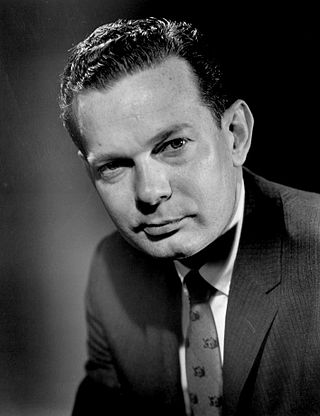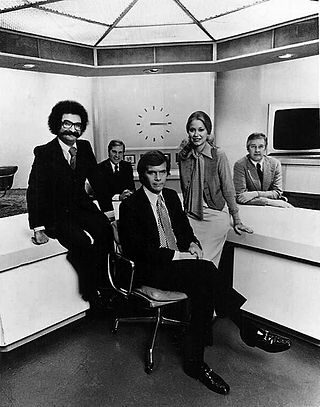
An announcer is a voice artist who relays information to the audience of a broadcast media programme or live event.
A news presenter – also known as a newsreader, newscaster, anchorman or anchorwoman, news anchor or simply an anchor – is a person who presents news during a news program on TV, radio or the Internet. They may also be a working journalist, assisting in the collection of news material and may, in addition, provide commentary during the program. News presenters most often work from a television studio or radio studio, but may also present the news from remote locations in the field related to a particular major news event.

The Huntley–Brinkley Report was an American evening news program that aired on NBC from October 29, 1956, to July 31, 1970. It was anchored by Chet Huntley in New York City, and David Brinkley in Washington, D.C. Oddly enough, Chet Huntley and David Brinkley never met in person. It succeeded the Camel News Caravan, anchored by John Cameron Swayze. The program ran for 15 minutes at its inception but expanded to 30 minutes on September 9, 1963, exactly a week after the CBS Evening News with Walter Cronkite did so. It was developed and produced initially by Reuven Frank. Frank left the program in 1962 to produce documentaries but returned to the program the following year when it expanded to 30 minutes. He was succeeded as executive producer in 1965 by Robert "Shad" Northshield and by Wallace Westfeldt in 1969.

The Early Show was an American morning television show that aired on CBS from November 1, 1999 to January 7, 2012, and the ninth attempt at a morning news-talk program by the network since 1954. The program aired Monday through Friday from 7:00 to 9:00 a.m., although a number of affiliates either pre-empted or tape-delayed the Saturday edition. The program originally broadcast from the General Motors Building in New York City.

David McClure Brinkley was an American newscaster for NBC and ABC in a career lasting from 1943 to 1997.

Television news in the United States has evolved over many years. It has gone from a simple 10- to 15-minute format in the evenings, to a variety of programs and channels. Today, viewers can watch local, regional and national news programming, in many different ways, any time of the day.
The National is a Canadian national television news program which serves as the flagship broadcast for the English-language news division of CBC News by the Canadian Broadcasting Corporation. It reports on major Canadian and international news stories, airing on CBC Television stations nationwide Sunday to Friday at 10:00 p.m. local time.

John William Chancellor was an American journalist who spent most of his career with NBC News. He is considered a pioneer in television news. Chancellor served as anchor of the NBC Nightly News from 1970 to 1982 and continued to do editorials and commentaries for NBC Nightly News with Tom Brokaw until 1993.

Floyd Kalber was an American television journalist and anchorman, nicknamed "The Big Tuna."

Eyewitness News is a style of television presentation that emphasizes visual elements and action videos, replacing the older "man-on-camera" newscast.

WTVE is a television station licensed to Willow Grove, Pennsylvania, United States, serving the Philadelphia area and primarily airing paid programming from OnTV4U. It is owned by WRNN-TV Associates alongside Princeton, New Jersey–licensed ShopHQ affiliate WMCN-TV and Trenton, New Jersey–licensed Class A station WPHY-CD. WTVE and WPHY-CD share studios on East State Street in Trenton; through a channel sharing agreement, the two stations transmit using WPHY-CD's spectrum from an antenna in the Roxborough section of Philadelphia.

Roger Olin Grimsby was an American journalist, television news anchor and actor. Grimsby, who for eighteen years was seen on ABC's flagship station WABC in New York City, is known as one of the pioneers of local television broadcast news.
Albert Thomas Primo was an American television news executive who was credited with creating the Eyewitness News format. More than a hundred markets have taken the Eyewitness News name to label their own featured local newscasts and others are using Primo's concept under different names for their own formats. "Eyewitness News was the first newscast to put [news] reporters on the set", Primo states in his autobiographical book, Eyewitness Newsman. The New York Daily News described Primo as the man "who almost single-handedly changed the face of broadcast journalism." Station newscasts were only 15 minutes long and he supervised the transition to thirty minute programs.

Fred Patterson Graham was an American legal affairs journalist, television news anchor, and attorney. He was the chief anchor and managing editor of the former Court TV. He also won a Peabody award for his work as a CBS law correspondent.

Kent Shocknek is an American television and film personality who branched into acting toward the end of a successful career as a TV newscaster. Because of the length of his journalism career, duration of his broadcasts, and breaking news events, by the time of his departure from news, he is credited with having logged more hours as an anchor than anyone else in Los Angeles. The city has designated two separate days "Kent Shocknek Day" in his honor. Before anchoring prime-time newscasts on CBS-TV owned stations, Shocknek was Southern California's first and longest-running television news morning news anchor. Because of his recognizability, he has been sought out to appear in more than 100 feature films and television dramas –often as a newscaster or commentator –giving rise to a popular second career that continues currently. On radio, Shocknek has narrated daily commentaries in L.A., and has hosted a nationally syndicated entertainment program. Viewers and magazine readers also recognize him as an authority on automotive issues.
Ted Baxter is a fictional character on the sitcom The Mary Tyler Moore Show (1970–1977). Portrayed by Ted Knight, the Baxter character is a broad parody of a vain, shallow, buffoonish, vacuous TV personality. Knight's comedic model was actor William Powell, and he also drew on Los Angeles newscasters, including George Putnam, to shape the character. The role was originally conceived for Jack Cassidy, but Cassidy turned it down; he later appears in the season two episode "Cover Boy" as Ted's equally egocentric brother Hal. Ted Baxter has become a symbolic figure often referenced when criticizing media figures, particularly news anchors hired for style and appearance rather than journalistic ability.
Carmela Corro Tiangco, professionally known as Mel Tiangco, is a Filipino television newscaster and television host. She is one of the news pillars of GMA News and Public Affairs and a multi-awarded news anchor.

Lawrence William McCormick was an American television actor, reporter and news anchor, most notably working for Los Angeles television station KTLA-TV.
David William McElhatton was an evening news anchor for several decades in San Francisco, California, in the United States. He was in the first class of inductees to the Bay Area Hall of Fame. He retired in 2000.

Xinwen Lianbo is a daily news programme produced by China Central Television (CCTV), a state broadcaster. It is shown simultaneously by all local TV stations in mainland China, making it one of the world's most-watched programmes. It has been broadcast since 1 January 1978.













